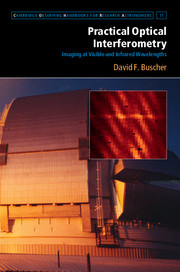Book contents
- Frontmatter
- Contents
- Principal symbols, functions and operators
- List of abbreviations
- Foreword
- Preface
- 1 Making fringes
- 2 Basic imaging
- 3 Atmospheric seeing and its amelioration
- 4 Interferometers in practice
- 5 Measurement noise
- 6 Interferometric observation of faint objects
- 7 Observation planning
- 8 Data reduction
- 9 Model fitting and image reconstruction
- Appendix A Fourier transforms
- Appendix B Supplementary online material
- References
- Index
1 - Making fringes
Published online by Cambridge University Press: 05 August 2015
- Frontmatter
- Contents
- Principal symbols, functions and operators
- List of abbreviations
- Foreword
- Preface
- 1 Making fringes
- 2 Basic imaging
- 3 Atmospheric seeing and its amelioration
- 4 Interferometers in practice
- 5 Measurement noise
- 6 Interferometric observation of faint objects
- 7 Observation planning
- 8 Data reduction
- 9 Model fitting and image reconstruction
- Appendix A Fourier transforms
- Appendix B Supplementary online material
- References
- Index
Summary
The need for angular resolution
Progress in astronomy is dependent on the development of new instrumentation that can provide data which are better in some way than the data which were available before. One improvement that has consistently led to astronomical discoveries is that of seeing finer detail in objects. In astronomy, the majority of the objects under study cannot easily be brought closer for inspection, so the typical angular scales subtended by objects, which depend on the ratio of the typical sizes of the objects to their typical distances from the Earth, are a more useful indicator of how easily they can be seen than their linear sizes alone. The angular separation of two features in a scene which can be just be distinguished from one another is called the angular resolution and the smaller this scale is, the more detail can be seen.
The impact of increased angular resolution can be appreciated from comparing the important angular scales of objects of interest with the angular resolution of the instrumentation available at different times in history. Prior to the invention of the telescope, the human eye was the premier ‘instrument’ in astronomy, with an angular resolution of about 1 arcminute (about 300 microradians). With the notable exceptions of the Sun, Moon and comets, most objects visible in the night sky are ‘star-like’: they have angular sizes smaller than 1 arcminute and so appear as point-like objects. The first telescopes improved the angular resolution of the naked eye by factors of three to six: Galileo's telescopes are thought to have had angular resolutions of about 10–20 arcseconds (Greco et al., 1993; Strano, 2009) and it became possible to see that planets appear as discs or crescents and have their own moons. Subsequent improvements to telescopes have culminated in telescopes like the Hubble Space Telescope (HST) which have typical angular resolutions of around 50 milliarcseconds (about 250 nanoradians) – better by a factor of more than a thousand than the naked eye.
- Type
- Chapter
- Information
- Practical Optical InterferometryImaging at Visible and Infrared Wavelengths, pp. 1 - 35Publisher: Cambridge University PressPrint publication year: 2015



